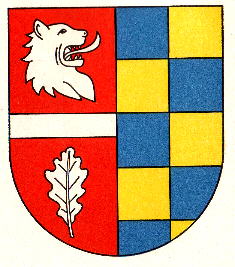Oberreidenbach: Difference between revisions
Jump to navigation
Jump to search
Knorrepoes (talk | contribs) m (Text replace - "|width="15%"|50 px|right |}" to "|width="15%"|50 px|right |}<seo title="Wappen, Gemeindewappen" />") |
Knorrepoes (talk | contribs) m (Text replace - " th e" to " the ") |
||
| Line 17: | Line 17: | ||
The arms were officially granted on October 14, 1964. | The arms were officially granted on October 14, 1964. | ||
The upper right corner shows a lion's head, which is based on the statue of a lion's head in | The upper right corner shows a lion's head, which is based on the statue of a lion's head in the village church. This statue probably dates from the time the village was settled and used to be connected to the local watch tower. The silver bend symbolises the Reidenbach river, whereas the oak leaf symbolises the old Kaisereiche tree in the village. The left half shows the chequered field of the Counts of Sponheim, who ruled the area for many centuries. | ||
Revision as of 05:57, 18 April 2013
| Heraldry of the World Civic heraldry of Germany - Deutsche Wappen (Gemeindewappen/Kreiswappen) |
OBERREIDENBACH
State : Rheinland-Pfalz
District (Kreis) : Birkenfeld
Verbandsgemeinde : Herrstein
Origin/meaning
The arms were officially granted on October 14, 1964.
The upper right corner shows a lion's head, which is based on the statue of a lion's head in the village church. This statue probably dates from the time the village was settled and used to be connected to the local watch tower. The silver bend symbolises the Reidenbach river, whereas the oak leaf symbolises the old Kaisereiche tree in the village. The left half shows the chequered field of the Counts of Sponheim, who ruled the area for many centuries.
Literature : Heyen und Zimmer, 1966

